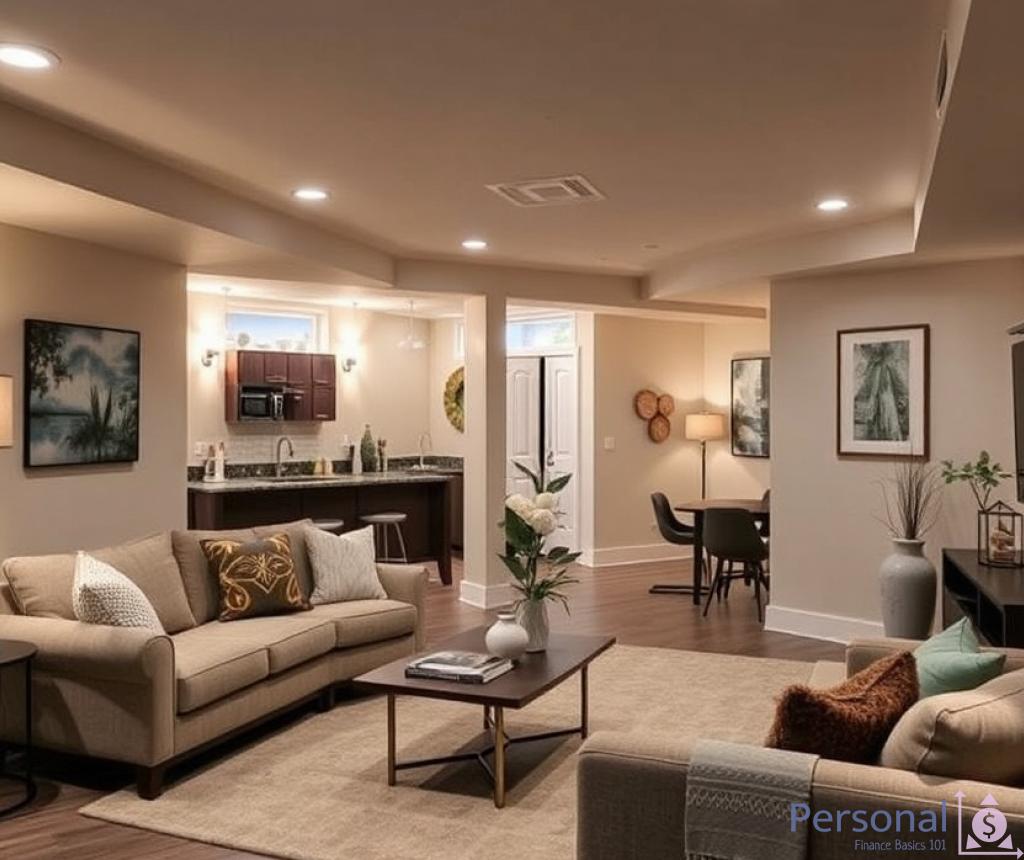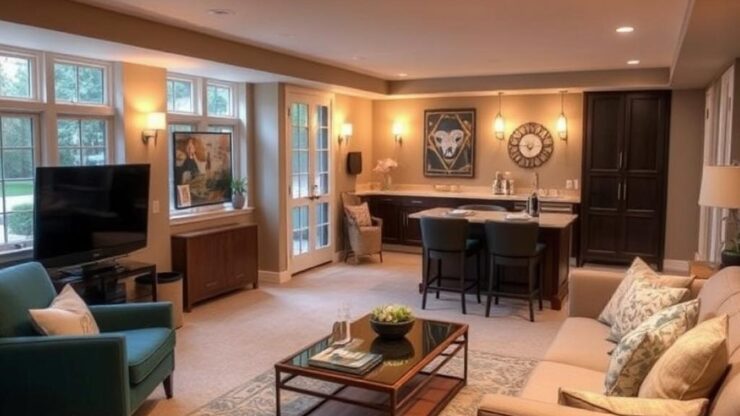Understanding the Benefits of Basement Finishing

Many homeowners overlook the basement as a potential living space, but with the right vision and effort, this underutilized area can become a stunning extension of your home. Finishing a basement not only enhances the aesthetics of your property but also offers numerous functional benefits that can significantly improve your quality of life and increase your home’s overall value.
Investing in basement finishing can yield impressive returns, making it a wise financial decision for homeowners. A well-finished basement can increase the resale value of your property by providing additional square footage that prospective buyers find appealing. In fact, many real estate experts suggest that basement renovations can recoup more than 70% of their costs upon sale.
| Renovation Type | Average Cost | Return on Investment (ROI) |
|---|---|---|
| Basic Finishing | $10,000 – $30,000 | 70% – 75% |
| Full Apartment Suite | $30,000 – $60,000 | 60% – 70% |
| Theater Room | $15,000 – $40,000 | 60% – 80% |
Finishing your basement creates more than just an additional room; it opens up a world of possibilities. Whether you envision a cozy family room, a dedicated home office, or a vibrant entertainment area, the options are virtually limitless. Moreover, a finished basement can serve as a private retreat for family members, offering a quiet space away from the hustle and bustle of the main living areas.
- Personalized Use: Tailor the space to meet your unique needs.
- Increased Comfort: Enjoy temperature-controlled environments with proper insulation.
- Enhanced Aesthetics: Create an attractive, welcoming environment that complements the rest of your home.
Key Design Considerations for Basement Spaces
Transforming a basement into a functional living area requires careful planning and attention to detail. As you embark on this journey, it’s crucial to consider various design elements that can significantly enhance both the usability and aesthetics of the space. From layout optimization to effective lighting strategies, each choice can lead to a more inviting environment and improve the overall value of your home.
One of the most important aspects of basement design is the layout. Unlike other areas of the home, basements often come with unique architectural features such as low ceilings and irregular shapes. Therefore, it is essential to assess the available space and determine the best use for each section. A well-thought-out layout not only ensures efficient use of space but also contributes to an open and airy feeling.
- Define Purpose: Clearly identify how you intend to use the basement—be it a recreational room, guest suite, or home office. This will guide your design decisions.
- Flow and Accessibility: Ensure that pathways are clear and that the areas flow into one another smoothly. Consider how people will move around the space.
- Furniture Arrangement: Select furniture that complements the dimensions of the room. Modular pieces can be advantageous for adapting to different configurations.
Basements often suffer from limited natural light, making strategic lighting a pivotal design consideration. Creating a warm, inviting atmosphere can be achieved through a combination of ambient, task, and accent lighting. Utilizing various lighting sources not only enhances the functionality of the space but also adds depth and character.
- Ambient Lighting: Install overhead fixtures or recessed lighting to create a general glow.
- Task Lighting: Incorporate lamps or under-cabinet lighting to illuminate specific areas where activities take place, such as reading or working.
- Accent Lighting: Use wall sconces or LED strips to highlight architectural features or artwork, adding visual interest.
In conclusion, finishing your basement is not merely about adding square footage but creating a harmonious environment that meets your lifestyle needs. By focusing on the layout and lighting, you can transform a dark, unused space into a vibrant extension of your home that enhances both living experience and property value.
Budgeting for Your Basement Renovation
Embarking on a basement renovation project can be an exciting yet daunting task, especially when it comes to managing your budget. Proper financial planning is essential to ensure that your vision for a transformed basement aligns with your financial resources. As you delve into the planning phase, it’s vital to understand the various costs associated with finishing a basement and how you can allocate your funds wisely to achieve maximum results.
Before you start making decisions about design and materials, take a comprehensive look at your financial situation. This involves evaluating your current savings, potential financing options, and the overall budget you can comfortably allocate for this renovation. It’s crucial to set a realistic budget that considers not only the direct costs of finishing the basement but also any unexpected expenses that might arise during the project. Remember that unforeseen challenges, such as plumbing or electrical issues, can add to your costs, so having a contingency fund of around 10-20% of your total budget can be a prudent measure.
When it comes to basement renovations, costs can vary significantly based on factors like the scope of work, materials chosen, and the level of customization desired. Key categories to consider include:
Labor Costs: Hiring professionals can account for a substantial portion of your budget. Depending on the complexity of the project and local labor rates, it’s wise to obtain multiple quotes from reputable contractors to ensure you are getting a fair price.
Materials: The quality of materials you choose will significantly impact your overall budget. From flooring to drywall and insulation, opting for higher quality materials may lead to increased costs upfront but can provide long-term savings through durability and energy efficiency.
Permitting and Inspection Fees: Depending on the extent of your renovation, you may need to secure permits, which can add to your budget. Always check local regulations to avoid any surprises that could delay your project.
By understanding these cost components, you can create a more accurate budget that reflects your renovation goals while ensuring financial feasibility.
Prioritizing Your Renovation Goals is equally important in the budgeting process. Determine which elements of the renovation are essential and which are optional. For instance, if your primary goal is to create a livable space, consider focusing your budget on insulation, flooring, and lighting before investing in elaborate design features. This strategic approach allows you to allocate resources effectively, ensuring that the most critical aspects of your renovation are addressed without overspending.
Choosing the Right Materials for Basement Finishing
When transforming a basement into a functional living area, the choice of materials plays a crucial role in defining the overall outcome. The right materials not only enhance the aesthetic appeal but also contribute to the longevity and functionality of the space. As homeowners embark on this renovation journey, understanding the unique requirements of a basement is essential to select materials that can withstand moisture, temperature fluctuations, and potential wear and tear.
Durability Meets Design: Selecting Flooring Options
Flooring is one of the most critical elements to consider when finishing a basement. Since basements are prone to moisture, it is vital to choose flooring materials that are both durable and water-resistant. Options such as luxury vinyl tile (LVT) and laminate flooring have gained popularity due to their ability to mimic the look of hardwood while being resistant to water damage. Unlike traditional hardwood, which can warp and buckle in humid conditions, LVT and laminate offer enhanced resilience and ease of maintenance. Additionally, incorporating area rugs can add warmth and comfort, making the space more inviting.
Walls That Breathe: Insulation and Finishing Materials
Insulating the walls is another essential aspect of basement finishing. The right insulation not only regulates temperature but also helps in preventing moisture buildup, which can lead to mold growth. Fiberglass batt insulation is a common choice due to its affordability and effectiveness. For a more eco-friendly option, consider rigid foam insulation, which provides excellent thermal resistance and moisture control. Once insulation is in place, homeowners can opt for drywall or other wall finishing materials that complement their design aesthetic. Using moisture-resistant drywall can add an extra layer of protection against dampness, ensuring the longevity of the finished space.
Lighting the Way: Choosing Fixtures and Finishes
To create a welcoming atmosphere in a finished basement, lighting is paramount. The selection of light fixtures can dramatically alter the perception of space. Recessed lighting is often favored for its ability to provide ambient light without taking up visual space. Additionally, incorporating dimmable fixtures allows homeowners to adjust the mood as desired. Beyond functional lighting, accent lights can be strategically placed to highlight architectural features or artwork. When combined with the right wall and ceiling finishes, effective lighting can transform a dark, uninviting basement into a bright, lively environment.
| Material Type | Durability | Moisture Resistance | Aesthetic Appeal |
|---|---|---|---|
| Luxury Vinyl Tile (LVT) | High | Excellent | Varied |
| Fiberglass Batt Insulation | Moderate | Good | Neutral |
| Moisture-Resistant Drywall | Moderate | Excellent | Varied |
| Recessed Lighting | High | N/A | Modern |
Choosing the right materials for basement finishing is a multifaceted process that requires careful consideration of functionality, durability, and aesthetics. By prioritizing materials that can withstand the unique conditions of a basement, homeowners can create a space that not only enhances their living experience but also adds significant value to their property.
Maximizing Natural Light in Finished Basements
Transforming a basement into a vibrant living space often presents unique challenges, one of the most significant being the limited natural light. However, the clever use of design strategies can create an inviting atmosphere that enhances both the functionality and aesthetic appeal of the area. By focusing on ways to maximize natural light, homeowners can turn a dark basement into a bright and welcoming extension of their home.
Enlarging Windows: A Bright Idea
One of the most effective methods to increase natural light in a basement is by enlarging existing windows or adding new ones. Larger windows allow more sunlight to flood the space, creating an open and airy feel. Homeowners should consider egress windows, which not only comply with safety codes but also provide ample daylight. Utilizing window wells can further enhance light penetration while ensuring a seamless integration with the home’s exterior. By embracing larger windows, your basement can become a luminous haven that feels connected to the outdoors.
Color Choices and Reflective Surfaces
The impact of color cannot be underestimated when it comes to illuminating a finished basement. Lighter shades on walls and ceilings can dramatically enhance the sense of space and brightness. Opting for whites, soft grays, or light pastels can reflect light effectively, giving the illusion of a well-lit area. Additionally, incorporating reflective surfaces such as glass accents or shiny finishes can amplify the light entering the space. This layered approach to color and materials not only uplifts the ambiance but also makes the basement a more enjoyable place to spend time.
Strategic Lighting Solutions
While maximizing natural light is essential, supplementing it with the right artificial lighting is crucial for achieving a balanced effect. Strategically placing light fixtures can help enhance the brightness during the evening or on cloudy days. Consider using recessed lighting to maintain a clean look while ensuring adequate illumination. Moreover, utilizing floor lamps or table lamps with adjustable brightness can create a warm and inviting atmosphere. By thoughtfully combining natural and artificial lighting, homeowners can enjoy a basement that feels bright, welcoming, and versatile for various activities.
Disclaimer
This article has been created or edited with the support of artificial intelligence and is for informational purposes only. The information provided should not be considered investment advice. Please seek the support of a professional advisor before making any investment decisions.






